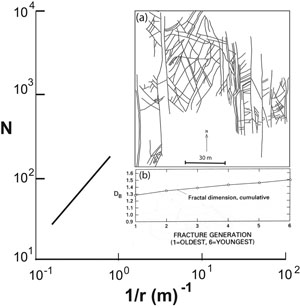| |||||||
|
|
|||||||
|
|
|||||||
| Geostatistical Properties of Multiple Joint Sets | |||||||
|
The dimensional properties of individual joints, joint sets, and joint zones have been described based on the data obtained by one dimensional methods. These methods can also be used for each of these categories as mentioned above, which exist as parts of more complex joint patterns. However, it is more appropriate to use 2D aerial methods to capture the scaling of joint networks. This includes measurements in the field using a sampling box of square or circular geometry or using sampling boxes of a greater range of size in the laboratory (Figure 1). Inset (a) in Figure 1 shows several generations of joint networks as deduced by Barton (1995). The main plot illustrates the fractal nature of the final product with a fractal number of 1.50. However, if the same procedure is applied to each generation network, the cumulative plot in Inset (b) shows a systematic evolution of the fractal numbers. It should be noted that all structures following the second generation are sheared joints which are 'faults' for all purposes. Given that following the first generation joints, the geometric and physical parameters which control the length and spacing of the younger generations vary significantly, it is somewhat surprising that the corresponding fractal numbers evolve systematically. Patterns of multiple joint sets refer to geometric arrangements of joint sets in multiple joint sets present in the same area which have implications for the stress system responsible for their formation, strength, and other mechanical properties of the fractured rock, and fluid flow through fractured rock. | |||||||
| Types of Geostatistical Properties of Multiple Joint Sets: | |||||||
| Geostatistical Properties of Columnar Joints | |||||||
| Reference: |
|||||||
| Barton, C.C., 1995 |
|||||||
|
Readme | About Us | Acknowledgement | How to Cite | Terms of Use | Ⓒ Rock Fracture Knowledgebase |
|||||||
